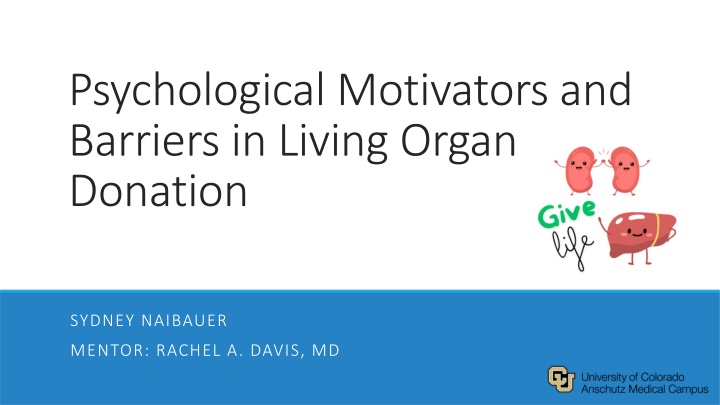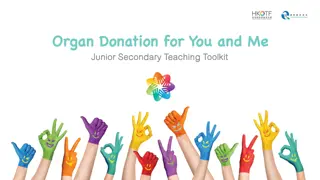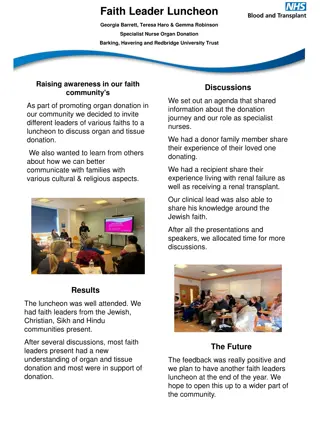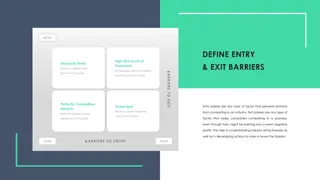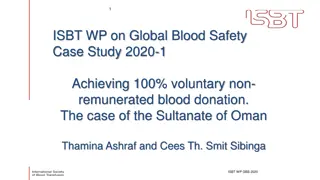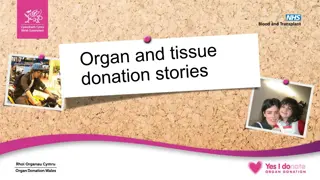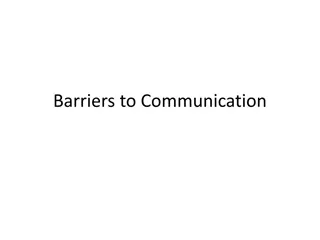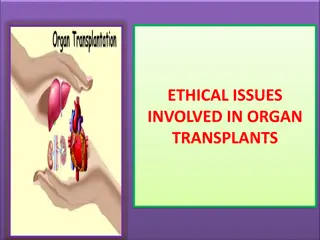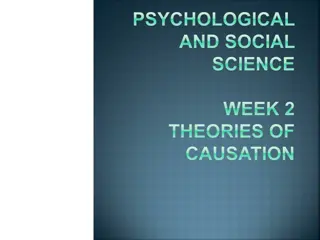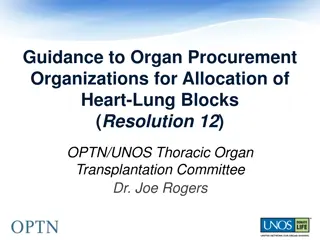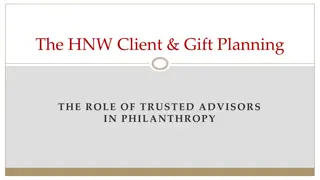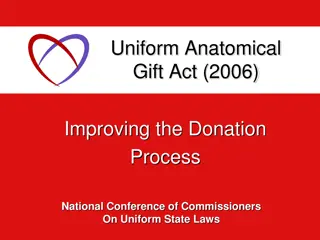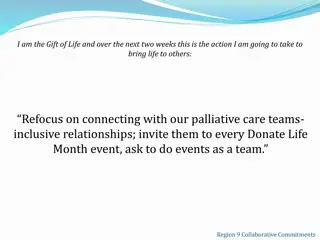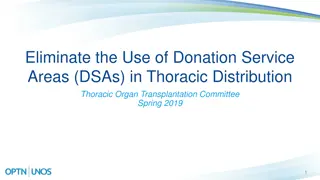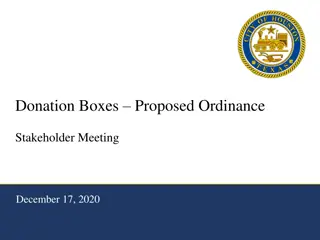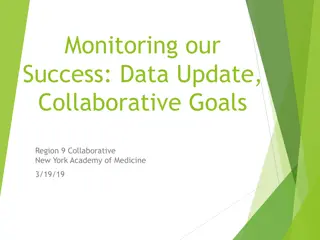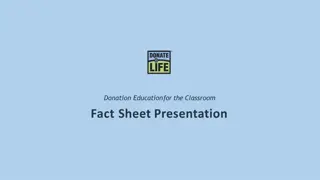Psychological Motivators and Barriers in Living Organ Donation
The willingness and factors impacting living organ donation through surveys and assessments on altruism, demographics, and perspectives. Insights to enhance donation rates.
Download Presentation

Please find below an Image/Link to download the presentation.
The content on the website is provided AS IS for your information and personal use only. It may not be sold, licensed, or shared on other websites without obtaining consent from the author.If you encounter any issues during the download, it is possible that the publisher has removed the file from their server.
You are allowed to download the files provided on this website for personal or commercial use, subject to the condition that they are used lawfully. All files are the property of their respective owners.
The content on the website is provided AS IS for your information and personal use only. It may not be sold, licensed, or shared on other websites without obtaining consent from the author.
E N D
Presentation Transcript
Psychological Motivators and Barriers in Living Organ Donation SYDNEY NAIBAUER MENTOR: RACHEL A. DAVIS, MD
Introduction In 2019, 4,925 people died while waiting for an organ in the United States [1]. <15% of organ donations in the US were from living donors in 2020 [2]. 22% of kidney transplants were from living donors in 2023 6% of liver transplants were from living donors in 2023 Most donations from living donors are directed donations to family members or friends. People may also donate to anonymous recipients (non-directed donation) through some transplant centers.
Introduction As of 8/12/24, there were 104,036 transplant waiting list candidates [3]. Kidney is the Organ Most Needed for Transplant Kidney Liver Other Organs
Objective 1 Evaluate participants willingness to consider becoming living organ donors under different circumstances.
Objective 2 Determine which factors are perceived as more motivating and which are perceived as more discouraging to living organ donation and potential associations with willingness to donate.
Methods: Survey Design 34 Questions: demographics, awareness, perspectives, altruism scale Participants spun a wheel for a prize 348 participants completed the survey on the CU Anschutz Medical Campus 65 participants completed 28 optional questions for the interpersonal reactivity index (IRI), an assessment of empathy
Altruism Scale Altruism facet of a personality inventory (HEXACO PI-R) Average of 4 questions scaled from 1-5
Demographics 70% Female 55% White/Caucasian Male Female Non-binary White/Caucasian Hispanic/Latino Black/African American Native American/American Indian Asian/Pacific Islander
Demographics Ages ranged from 18-70, with an average of 30 Income Level Level of Education No college Bachelor's Degree Trade School Master's Degree Associate's Degree Doctoral Degree < $50k $50k-$100k $100k-$150k > $150k
Methods: Statistical Analysis Analysis of data performed using SPSS. Wilcoxon signed rank tests compared paired responses for different scenarios. Kruskal-Wallis tests were used to compare scores and levels for three groups defined by willingness to donate non-directed (yes, maybe, no).
Results: Willingness to Donate 53% of participants said yes to considering donating to a loved one. 22% of participants said yes to considering donating to a stranger. Higher altruism for participants who said yes to anonymous donation
Interpersonal Reactivity Index A one-way ANOVA compared IRI results by willingness to donate non-directed (yes, maybe, no). Results were not statistically significant (p > 0.05). No relationship between empathy and willingness to donate non- directed Statistically significant relationship between participant willing to fill out the optional IRI questions and altruism (p < 0.001)
Discussion: Willingness and Circumstances Willingness to consider living organ donation was higher than expected for both loved ones (53%) and strangers (22%) More likely to donate to recipients with characteristics: Alcohol-Related Liver Disease Immune Disorder Infant Adult Relative Non-Relative Non-Relative with Alcohol- Related Liver Disease Sibling with Alcohol-Related Liver Disease
Discussion: Motivating and Discouraging Factors Strongest Motivators: Child Recipient High success rate of transplant center Helping someone in need/save a life Help a family member or friend Strongest Discouragers: Risk of surgery Uncompensated expenses Difficulty of Recovery Length of Recovery
Future Implications Additional research could examine the perspectives of other populations on living organ donation. Surveys are planned for distribution at tattoo shops in Denver so results can be compared to those from the medical campus sample. Results may be used to guide development of educational and recruitment materials.
References [1] Lewis A, Koukoura A, Tsianos GI, Gargavanis AA, Nielsen AA, Vassiliadis E. Organ donation in the US and Europe: The supply vs demand imbalance. Transplant Rev (Orlando). 2021 Apr;35(2):100585. doi: 10.1016/j.trre.2020.100585. Epub 2020 Oct 11. PMID: 33071161. [2] The Lancet Gastroenterology Hepatology. Removing barriers to living organ donation. Lancet Gastroenterol Hepatol. 2021 May;6(5):335. doi: 10.1016/S2468-1253(21)00104-7. PMID: 33857439. [3] Organ Procurement & Transplantation Network. (2018). Data - OPTN. Hrsa.gov. https://optn.transplant.hrsa.gov/data/
Acknowledgements Special thank you to: Dr. Ron-Li Liaw, Chair of PMHI Dr. Neill Epperson, Chair of Department of Psychiatry Dr. Dominic Martinez, Dir. Office of Inclusion and Outreach, CCTSI Dr. Rachel A. Davis, primary mentor Dr. Tyler Branagan, co-investigator Dr. Susan Mikulich-Gilbertson, co-investigator Dr. Stephanie Lehto, co-investigator Yunliang (Lily) Luo, Director PURPLE Program Shanna Trott, Director PURPLE Program Dr. Merlin Ariefdjohan, PURPLE Program Founder and Faculty Advisor
Recovery from Donation Typical surgical risks from major surgery Liver: Stay in hospital for up to 1 week after (or more) Liver regrows to normal size in 2 months, most can return to normal activity Kidney: Most kidney donors recover in the hospital for 2-5 days before heading home 6-8 weeks to fully heal. During this time, you shouldn't lift anything heavier than about 10 pounds
Financial Burden from Donation Recipient s insurance covers donor s medical expenses May not cover follow-up expenses from additional treatment or complications Doesn t cover lodging, childcare, lost wages Living donors legally can t get paid for donating The National Living Donor Assistance Center may provide financial support for travel, lodging, meals, other non-medical expenses for 90 days after surgery Some donors have trouble getting, affording, or keeping health, disability, or life insurance Premiums can increase If you don t have insurance, serving as a donor can be considered pre-existing condition if you try to get insurance later
